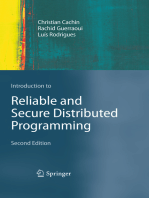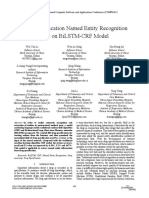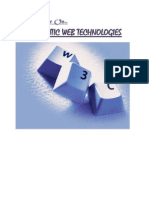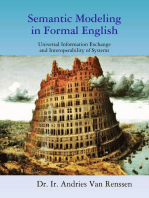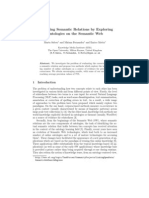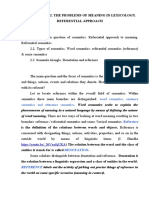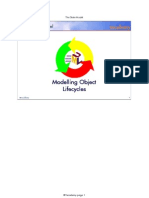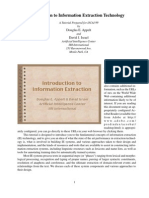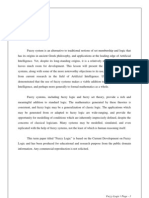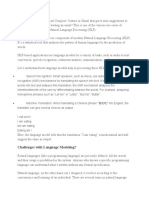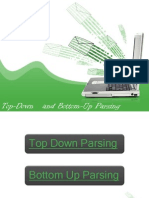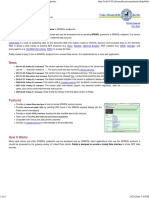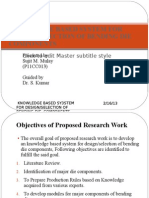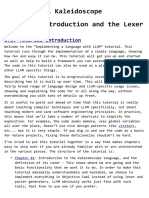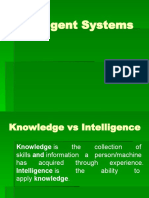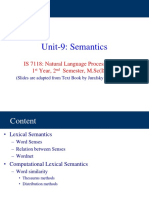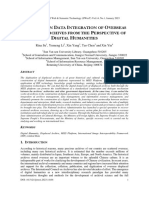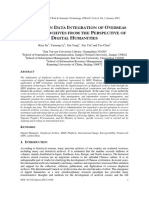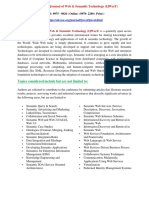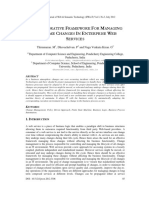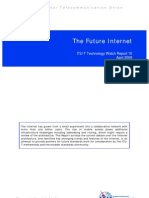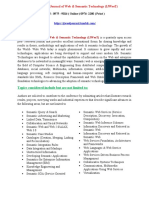Semantic - Based Querying Using Ontology in Relational Database of Library Management System
Semantic - Based Querying Using Ontology in Relational Database of Library Management System
Uploaded by
ijwestCopyright:
Available Formats
Semantic - Based Querying Using Ontology in Relational Database of Library Management System
Semantic - Based Querying Using Ontology in Relational Database of Library Management System
Uploaded by
ijwestOriginal Description:
Copyright
Available Formats
Share this document
Did you find this document useful?
Is this content inappropriate?
Copyright:
Available Formats
Semantic - Based Querying Using Ontology in Relational Database of Library Management System
Semantic - Based Querying Using Ontology in Relational Database of Library Management System
Uploaded by
ijwestCopyright:
Available Formats
International Journal of Web & Semantic Technology (IJWesT) Vol.2, No.
4, October 2011
Semantic Based Querying Using Ontology in Relational Database of Library Management System
Ayesha Banu1 , Syeda Sameen Fatima2 and Khaleel Ur Rahman Khan3
1
Asso.Professor, Dept. of Informatics, Alluri Institute of Management Sciences, KU, Warangal.
ayeshaaims@gmail.com
2
Professor, Dept. of C.S.E , Univ. College of Engineering ,OU , Hyderabad
sameenf@gmail.com
3
Professor, Dept.of C.S.E, ACE Engineering College , JNTU, Hyderabad
khaleelrkhan@aceec.ac.in
ABSTRACT:
The traditional Web stores huge amount of data in the form of Relational Databases (RDB) as it is good at storing objects and relationships between them. Relational Databases are dynamic in nature which allows bringing tables together helping user to search for related material across multiple tables. RDB are scalable to expand as the data grows. The RDB uses a Structured Query Language called SQL to access the databases for several data retrieval purposes. As the world is moving today from the Syntactic form to Semantic form and the Web is also taking its new form of Semantic Web. The Structured Query of the RDB on web can be a Semantic Query on Semantic Web. The SPARQL is the Query Language recommended by W3C for the RDF(Resource Description Framework). RDF is a directed, labeled graph data format for representing information in the Web and is a very important layer of the Semantic Web Architecture. In this paper we consider the Library Management System (LMS) database, taking some tuples of the LMS Relational Schema. We discuss how the RDF code is scripted and validated using RDF Validator and how RDF Triples are generated. Later we give the graphical representation of the RDF triples and see the process of extracting ontology from the RDF Schema and application of the Semantic Query.
KEYWORDS:
Semantic Web, Ontology, Semantic Query, Relational Database.
1. INTRODUCTION
Todays Web is a big pool of information stored in various forms. The World Wide Web has also changed the way people communicate with each other. Most of the web content today is suitable for human consumption with typical uses involving searching for the required information, reviewing the online stores and placing order for products and many more. The main tools people
DOI : 10.5121/ijwest.2011.2402 21
International Journal of Web & Semantic Technology (IJWesT) Vol.2, No.4, October 2011
use to search todays web are the keyword based search engines like Google and Yahoo. Even if the search is successful the person has to still browse the retrieved documents further to extract the exact information he is looking for. The main obstacle to provide a better support to web user is that the meaning of the web document is not machine-accessible. There are tools which can retrieve texts , count number of words and check their spelling but when it comes to interpreting the sentences and extracting information useful to users the capability of current softwares is limited. The solution for this is provided by the Semantic Web where traditional Web is focused on people, the Semantic Web is focused on machines. The Web requires a human operator, using computer systems to perform the tasks required to find, search and aggregate its information. It's impossible for a computer to do these tasks without human guidance because Web pages are specifically designed for human readers. The Semantic Web aims to change it by presenting Web page data in such a way that it is understood by computers, enabling machines to do the searching, aggregating and combining of the Webs information without a human operator. The organization of this paper is as follows: Section 2 presents the concept of Semantic Web and its major layers. Section 3 focuses on the Related Work for the process of building ontology based query for the relational database (Library Management System Database). Section 4 describes the Semantic Query in the RDB and Section 5 concludes the paper.
2.SEMANTIC WEB CONCEPTS AND BACKGROUND
In this section we describe the basic concepts of the Semantic Web, its layered architecture, different languages for the semantic web , ontology , RDF Triple RDS(Relational Database Scheme) and RDFS(RDF Schema).
2.1. The Semantic Web
The Semantic Web (SW) is an extension of the current web where the information is presented in a well-defined manner, better enabling computers and people to work in cooperation.[1] BernersLee suggested a layer structure for the Semantic Web as shown below: [ Figure Source:en.wikipedia.org/wiki/Semantic_Web_Stack]
22
International Journal of Web & Semantic Technology (IJWesT) Vol.2, No.4, October 2011
Figure 1: The Layered Architecture of Semantic Web The architecture of the Semantic Web can be classified as four major parts 1. 2. 3. 4. XML : The Representation Layer RDF : The Knowledge Representation Layer RDF Schema : The Ontology Layer Agents : The Logic , Proof and Trust Layers
2.2. Languages for the Semantic Web
There are many languages proposed for semantic web where every language has its own utility and style of scripting and working. Some of the languages for Semantic Web can be [2]: HTML (Hyper Text Markup Language): is the standard language in which Web pages are written. HTML was designed only for the purpose of displaying the data and it has no separation between the logical structure of the web page and the actual data of the page. This raised the difficulty in understanding the syntax and semantics. XML (Extensible mark-up language): was designed as a language for mark-up or annotation of documents. XML separates the logical structure of the data from data itself. An XML object is a labeled tree and consists of objects with attributes and values. XML allows the definition of any kind of annotation, which opens the way to annotation with ontologies. XML Schema allows the definition of grammars for valid XML documents, but XML cannot recognize the semantics of information.
23
International Journal of Web & Semantic Technology (IJWesT) Vol.2, No.4, October 2011
RDF (Resource Description Framework): To recognize the semantics of information RDF is proposed which represent information in a concept representation language. RDF is the widely accepted standard proposed by W3C Consortium for representing metadata. RDF documents consist of three types of entities: resources, properties, and statements. Resources may be Web pages or parts of Web pages. Properties are specific attributes, characteristics, or relations describing resources. Statements can the objectattributevalue triples. RDF Schema (RDFS): defines a simple modeling language on top of RDF which includes classes, is-a relationship between classes and between properties, and domain/range restrictions for properties. RDF and RDF Schema are written in XML syntax. OWL (Web Ontology Language): Like RDF and RDF Schema, OWL is a W3C recommendation, intended to support more elaborate semantics. OWL includes elements from description logics and provides many constructs for the specification of semantics, including conjunction and disjunction, existentially and universally quantified variables and property inversion. SPARQL: SPARQL (pronounced as "sparkle") is an RDF query language, stands for SPARQL Protocol and RDF Query Language. It was standardized by the RDF Data Access Working Group (DAWG) of the World Wide Web Consortium.
2.3. The Ontology
Ontology stands as the most important concept in Semantic Web, which can be defined as a collection of key concepts and their inter relationship providing an abstract view of an application domain. The Ontology enables both user and system to communicate with each other by the shared and common understanding of a domain [3]. For the web, ontology is about the exact description of web information or web resources and the relationship between them. RDF (Resource Description Framework) can be used for describing the web resources and the relationship between them. The fundamental concepts of RDF are Resources, Properties and Statements. Resources can be any object about which we would think. A resource may be an author or a book or a publisher and so on. Every resource has a Uniform Resource Locator (URL) or Web Address. Properties are special kinds of resources which describe the relation between the resources. For example title (title of a book), age (age of any person) and so on. These properties in RDF are also identified by URLs. Statements assert or declare the properties of resources. A statement in RDF is Object-PropertyValue triple consisting of a resource (Object), property (the property of the resource) and value (is the property value of the resource) [4]. The graphical representation of a RDF triple can be shown as below:
24
International Journal of Web & Semantic Technology (IJWesT) Vol.2, No.4, October 2011
Object
Property
Value
Figure 2: Graphical Representation of RDF Triple
3. RELATED WORK
To understand how the RDF triples are formed , how the RDF code is produced and validated and how the Graphical Representation is done, we consider the following example table of 2 books with its title , author , and price and published year given in the table.
Table 1: Book Details Book Title Data Mining Semantic Web Author Arun.K.Pujari Tim Berners Lee Price $56 $65 PubYear 1999 2004
For the above data regarding books details the RDF code can be written as follows [8]: <?xml version="1.0"?> <rdf: RDF xmlns:rdf="http://www.w3.org/1999/02/22-rdf-syntax-ns#" xmlns:lib="http://www.libraryexample.cm/lib#"> <rdf:Description rdf:about="http://www.libraryexample.cm/lib/DataMining"> <lib:author>Arun.k.Pujari</lib:author> <lib:price>$56</lib:price> <lib:pubyear>1990</lib:pubyear> </rdf:Description> <rdf:Description rdf:about="http://www.libraryexample.cm/lib/SemanticWeb"> <lib:author>Tim Brener's Lee</lib:author> <lib:price>$65</lib:price> <lib:pubyear>2004</lib:pubyear> </rdf:Description> </rdf:RDF> The above code can now be subjected against the RDF Validator and Converter to check for the syntax validation of the code and obtain the RDF Triples. Demo version of the RDF validator can
25
International Journal of Web & Semantic Technology (IJWesT) Vol.2, No.4, October 2011
be available at http://www.rdfabout.com/demo/validator/ .The results of RDF Validator and Converter for the above code can be
RDF Validation Result Syntax validated OK.
The document as Notation 3
@prefix lib: <http://www.libraryexample.cm/lib#>. @prefix rdf: <http://www.w3.org/1999/02/22-rdf-syntax-ns#>. <http://www.libraryexample.cm/lib/DataMining> lib:author "Arun.k.Pujari"; lib:price "$56"; lib:pubyear "1990". <http://www.libraryexample.cm/lib/SemanticWeb> lib:author "Tim Brener's Lee"; lib:price "$65"; lib:pubyear "2004".
The underlying triples
<http://www.libraryexample.cm/lib/DataMining> <http://www.libraryexample.cm/lib#author> "Arun.k.Pujari". <http://www.libraryexample.cm/lib/DataMining> <http://www.libraryexample.cm/lib#price> "$56". <http://www.libraryexample.cm/lib/DataMining> <http://www.libraryexample.cm/lib#pubyear> "1990". <http://www.libraryexample.cm/lib/SemanticWeb> <http://www.libraryexample.cm/lib#author> "Tim Brener's Lee". <http://www.libraryexample.cm/lib/SemanticWeb> <http://www.libraryexample.cm/lib#price> "$65". <http://www.libraryexample.cm/lib/SemanticWeb> <http://www.libraryexample.cm/lib#pubyear> "2004".
The Graphical representation of the RDF triples can result in a RDF Graph [9]. A part of RDF Graph for above example can be as shown
Figure 3: Graphical Representation of our Example RDF Triple
3.1. RDB and RDFS
Relational Databases are used more to store the content of the website. The integration of XML with relational database systems to enable the storage, retrieval, and update of data is of major
26
International Journal of Web & Semantic Technology (IJWesT) Vol.2, No.4, October 2011
importance [5]. But today many of the Web-based information systems do not aim at purely providing read-only access to their content which is simply represented in terms of web pages stored in the web servers directory but provide more access to their data. [6]. So Compared to XML and relational databases, which are structural-oriented, RDF takes into consideration a knowledge oriented approach that is designed specifically for the Web and that is extremely useful for the Semantic Web. One of the advantages of RDF over XML and relational model is that an RDF graph depicts in a unique form the information to be conveyed. Following table shows the relationship between the Entity Relationship Model (Structural model) and the ontology model (Semantic model) [3] Table 2: The Relationship between ER-Model and Ontology Model
Graphical Representation ER-Model Ontology Implementation Schema Relational Schema RDF Schema Instances Relational Database RDF Modeling Data Modeling Knowledge Modeling
ER Model Ontology Model
4. BUILDING ONTOLOGY BASED QUERY
To build the ontology based query for the Library Management System database we consider the framework proposed in[3] consisting of 2 phases, offline ontology extraction and online query issuing. In offline ontology extraction, the system extracts the explicit classes and relations from the relational schema. Then the domain expert will adapt the extracted ontology by adding the implicit relations to complete the ontology. In online query operation the user can issue a semantic query to the system, and the system maps that query into a related SQL query for the underlining relational database. The framework can be as shown:
Figure 4: Framework for querying relational database based on ontology
27
International Journal of Web & Semantic Technology (IJWesT) Vol.2, No.4, October 2011
4.1. Extracting Ontology from Relational Database
BOOK, MEMBER and PUBLISHER are the basic entities for the example database we use . Every Library has books with unique id, title, author, price and status (available or not). Members of the library borrow books and every member has member id, name, address and member type (student/professor/researcher). Library also maintains the details of publishers of the books including the publisher id, name and address. The database also maintains the complete book details and issue details. The complete Relational Database of the Library Management System considered can be shown in table below. Table 3: A Relational Database for the Library Management System Relation Primary Key Book(Bid,Title,Author,Price,Status,Mid,Pid) Bid Member(Mid,Mname,Addr,Mtype) Publisher(Pid,Pname,Addr) IssueDetails(Mid,Mname,Bid,Title,Doi,Dor) Mid Pid Bid , Mid Foreign Key Mid ref. to Member Pid ref. to Publisher
Bid ref. to Book Mid ref. to Member BooksDetails(Bid,Title,Price,Pid,Pname) Bid,Pid Bid ref. to Book Pid ref. to Publisher In the semi-automatic process of extracting ontology from relational database we apply some rules like. Rule1: If the primary key of any relation is unique and do not contain the primary key of any other relation then we consider such relation as on ontological class. As per our Library example Member and Publisher are separate Ontological classes. lib:Member (Mid,Mname,Addr,Mtype) lib:Publisher (Pid,Pname,Addr) rdf:type rdfs:class.
rdf:type
rdfs:class.
Rule2: If the foreign key of any relation R1 is the Primary key of any other relation R2 then there exists an object property from R1 to R2 and the domain is R1 and range is R2. As per our Library example members borrow books from library so Borrowerid from Borrow can be an object property with domain as Member and range as Book. lib:Borrow lib:Borrow lib:Borrow rdf:type rdfs:domain rdf:range rdf:property. rdf:Member. rdf:Book.
Many more rules of such type can be applied to extract the ontology from the relational database. Following figure shows the extracted ontology where all the class and the data type properties are defined but some object type properties are not yet defined.
28
International Journal of Web & Semantic Technology (IJWesT) Vol.2, No.4, October 2011
Figure 5: The Extracted Wrapper Ontology The next step will be to adapt the extracted ontology to pre-defined domain ontology. This stage will add the explicit definition of the implicit relationships and adjust directions of the object properties between classes. For example the property (relation) between the Book and Publisher classes is not fully defined yet. Based on the domain ontology, the obtained full wrapper ontology is shown as:
Figure 6: The Full Wrapper Ontology
29
International Journal of Web & Semantic Technology (IJWesT) Vol.2, No.4, October 2011
The following RDF Schema Triples notation is the part of the whole schema. . . lib:Book rdf:type rdfs:class lib:Member rdf:type rdfs:class lib:Publisher rdf:type rdfs:class lib:PublishedBy rdf:type rdf:property lib:PublishedBy rdfs:domain rdf:Book lib:PublishedBy rdf:range rdf:Publisher . (Here lib is the namespace for the extracted ontology)
4.2. SEMANTIC QUERY IN RDB (Relational Data Base)
After extracting and refining the wrapper ontology, the user can issue semantic queries based on extracted ontology concepts (Keywords) and these queries will be mapped onto plain syntactic SQL queries. The semantic queries will be based on SPARQL(pronounced as "sparkle") is an RDF query language, stands for SPARQL Protocol And RDF Query Language. SPARQL can be used to express queries across diverse data sources, whether the data is stored natively as RDF or viewed as RDF via middleware[7]. SPARQL contains capabilities for querying required and optional graph patterns along with their conjunctions and disjunctions. SPARQL also supports extensible value testing and constraining queries by source RDF graph. The results of SPARQL queries can be result sets or RDF graphs. Following is the SPARQL syntax query to find the member details (Mname, Mtype, and Addr) who have borrowed the book titled Data Mining from the Library. Prefix lib: http://www.libraryexample.cm Select ?Mname ?Mtype ?Addr ?Title Where { ?s lib:Mid ?p. ?p lib:Mname ?Mname. ?p lib:Mtype ?Mtype. ?p lib:Addr ?Addr. ?p lib:Borrow ?q. ?q lib:Bid ?r. ?r lib:Title?Title. } ?Title=Data Mining The above SPARQL query is translated to SQL query by following procedure [3]. The triples that share the same subject are grouped as they represent the same table information. So, each group represents some information about one concept in mediated ontology. For example, ?p subject group represent the Member information. Based on the mapping information, the translation algorithm replaces all predicates in the triples with corresponding columns name in relational databases tables. For example Mname, Mtype, and Addr are there in the Member table.
30
International Journal of Web & Semantic Technology (IJWesT) Vol.2, No.4, October 2011
If the predicate is not in the columns name, then it will be in object property names which are related to the linking tables. For example the Borrow property is not their in any table column. By inspection, it is in the mediated ontology linking the Member concept to the Book concept. For each separate group, a subquery clause is created, which consists of three parts: Select clause, From clause and Where clause. The Select clause is created according variable that occurs both in triple and in SPARQL select clause. The From clause is created according the column name in the triples. And the Where clause is created according the columns and mapping information. After all clauses are created, they are combined to construct the complete a query clause. For the SPARQL query given above ,the SQL query translated is below. Select Member.Mname , Member.Mtype , Member.Addr , Book.Title From Member,Book Where Member.Mid=Book.Mid and Book.Title=Data Mining;.
5. CONCLUSION
As we know that the traditional web includes a huge amount of Relational Databases (RDB) that support structuring data on a syntactic base. Converting available data stored in relational database into RDF format is tedious and error prone. So, instead of migrating available legacy data in relational database into RDF format based on ontology, we can build a wrapper that act as a translator from the semantic queries issued to the system into the syntactic data available within these databases. So this approach of extracting ontology from the RDB and allowing user to issue a semantic query and translating it into syntactic sql query and then transforming the results set obtained from relational databases into RDF triples using namespaces is more beneficial. There are many more concepts involved in mapping the semantic query using schema ontology into sql statements which can also be considered for implementation.
6. REFERENCES
[1] Gerd Stumme, Andreas Hotho, Bettina Berendt , Semantic Web Mining State of the Art and Future Directions: A Survey Web Semantics: Science, Services and Agents on the World Wide Web Volume 4, Issue 2, June 2006, Pages 124-14 Bettina Berendt, Andreas Hotho, Dunja Mladenic,Maarten van Someren, Myra Spiliopoulou, Gerd Stumme , A Roadmap for Web Mining: From Web to Semantic Web Mostafa E. Saleh , Semantic-Based Query in Relational Database Using Ontology , Canadian Journal on Data, Information and Knowledge Engineering Vol. 2, No. 1, January 2011. Grigoris Antoniou, Frank Van Harmelen , A Semantic Web Premier , Second Edition, MIT Press.
[2]
[3]
[4]
[5]
Gerti Kappel, Elisabeth Kapsammer and Werner Retschitzegger, " Integrating XML and Relational Database Systems", World Wide Web: Internet and Web Information Systems, 7, 343384, 2004, Kluwer Academic Publishers. 31
International Journal of Web & Semantic Technology (IJWesT) Vol.2, No.4, October 2011 [6] D. Florescu, A. Levy, and A. Mendelzon, Database techniques for the world wide web: a survey, ACM SIGMOD Record 27(3), 1998. Chunying Zhou,, Yaowen Zheng, Query Rewriting from SPARQL to SQL for Relational Database Integration , IEIT Journal of Adaptive & Dynamic Computing, Vol. 1, No. 1, 1-8 Ora Lassila, and Ralph R. Swick, Resource Description Framework (RDF) Model and Syntax Specification W3C Recommendation, 1999 Dan Brickley, and R.V. Guha, Resource Description Framework (RDF) Schema Specification, W3C Recommendation, 1999. Peng Liu, Xiaoying Wang, Aihua Bao and Xiaoxuan Wang , Ontology Automatic Constructing Based on Relational Database Grid and Cooperative Computing (GCC), IEEE 9th International 2010. Xu Zhou, Guoji Xu andLei Liu , An Approach for Ontology Construction Based on Relational Database , International Journal of Research and Reviews in Artificial Intelligence Vol. 1, No. 1, March 2011. Olivier Corby, Leila Kefi-Khelif, Hacne Cherfi, Fabien Gandon and Khaled Khelif , Querying the Semantic Web of Data using SPARQL, RDF and XML
[7]
[8]
[9]
[10]
[11]
[12]
Authors Ayesha Banu is a Post Graduate in M.Sc (CS) from Kakatiya University in 2002 and M.Tech (CSE) from JNTUH in 2009 and she is pursuing her PhD from JNTUH in the Area of Semantic Web Mining. She worked as a Lecturer in Masterji PG college from 2003 to 2006 and as Asst. Professor in Alluri Institute of Management Sciences from 2007 to 2009 and presently working as Associate Professor in Department of Informatics in same college since May 2010. She is a Life Member of ISTE and APSMS. She has delivered Guest Lectures in ACE Engg. Colege ,MGIT , Deccan college of Engg and GNITS. On Research issues in data mining , clustering techniques. Dr. Syeda Sameen Fatima obtained B.Tech., Electronics and Communication Engineering from JNTU in 1982 , M.Phil., Computer Methods, University of Hyderabad, India in 1983 , M.S., Computer Science, University of Massachusetts, Amherst, USA in 1993 and Ph.D. in Computer Science and Engineering, from Osmania University, India in 2004. Her Research interests Include Information Retrieval Systems, Data Mining ,Artificial Intelligence, Machine Learning. She ha 25 years of teaching experience and is presently working as Professor and Head , Dept of CSE , Univ. College of Engineering , OU , Hyderabad. She has published papers in various National and International Journals and Conferences. Khaleel Ur Rahman Khan obtained B.E. (CSE) from Osmania University in 1993 and M.Tech (CS) from JNTU in 1998. PhD in Computer Science from Osmania University in the area of Wireless Mobile Ad Hoc Networks. He is presently working as Professor and Dean at ACE Engineering. His research interests include Heterogeneous Networks, Opportunistic Networks, Transaction Management in Ad Hoc and Sensor Networks, Data and Web Mining. He has published over 30 papers in various Peer Reviewed International Journals and Conferences. He has teaching experience of over 18 years. 32
You might also like
- Introduction to Reliable and Secure Distributed ProgrammingFrom EverandIntroduction to Reliable and Secure Distributed ProgrammingNo ratings yet
- Drug Specification Named Entity Recognition Base On BiLSTM-CRF Model PDFDocument5 pagesDrug Specification Named Entity Recognition Base On BiLSTM-CRF Model PDFEduardo LacerdaNo ratings yet
- Semanti Web TechnologiesDocument11 pagesSemanti Web TechnologiesHarika MnNo ratings yet
- A Survey of Semantic Based Solutions To Web MiningDocument8 pagesA Survey of Semantic Based Solutions To Web MiningInternational Journal of Application or Innovation in Engineering & ManagementNo ratings yet
- Semantic Web: Seminar ReportDocument13 pagesSemantic Web: Seminar ReportgbrmmtNo ratings yet
- Knowledge RepresentationDocument10 pagesKnowledge Representationrotago6843No ratings yet
- Evaluating Semantic Relations by Exploring Ontologies On The Semantic WebDocument12 pagesEvaluating Semantic Relations by Exploring Ontologies On The Semantic WebMarta SabouNo ratings yet
- The Question Answering System Using NLP and AIDocument6 pagesThe Question Answering System Using NLP and AIAli WalidNo ratings yet
- Generating Semantic AnnotationsDocument78 pagesGenerating Semantic AnnotationsPal Vadasz100% (1)
- A Classification of Adjectives For Polarity Lexicons EnhancementDocument5 pagesA Classification of Adjectives For Polarity Lexicons EnhancementacouillaultNo ratings yet
- Employing A Domain Specific Ontology To Perform Semantic SearchDocument13 pagesEmploying A Domain Specific Ontology To Perform Semantic Searchmona4No ratings yet
- 024 KnowledgeRepresentationMethods (Puhr)Document18 pages024 KnowledgeRepresentationMethods (Puhr)anwarussaeedNo ratings yet
- Diff Classification and TaxonomyDocument8 pagesDiff Classification and Taxonomymanoj_thomas_9No ratings yet
- Simulation of Spacecraft Attitude and Orbit DynamicsDocument6 pagesSimulation of Spacecraft Attitude and Orbit DynamicsDan PhanNo ratings yet
- An Integrated Approach To Extracting Ontological SDocument16 pagesAn Integrated Approach To Extracting Ontological SMaría MarchianoNo ratings yet
- Create New LanguageDocument26 pagesCreate New LanguagepuneetNo ratings yet
- Ontology Mapping - An Integrated Approach: Abstract. Ontology Mapping Is Important When Working With More Than OneDocument15 pagesOntology Mapping - An Integrated Approach: Abstract. Ontology Mapping Is Important When Working With More Than OneIanus72No ratings yet
- Engineering Design Knowledge Representation Based On Logic and ObjectsDocument19 pagesEngineering Design Knowledge Representation Based On Logic and ObjectsnuesteNo ratings yet
- Word Semantics, Sentence Semantics and Utterance SemanticsDocument11 pagesWord Semantics, Sentence Semantics and Utterance SemanticsАннаNo ratings yet
- Simple Knowledge Organization System (SKOS) in 10 PointsDocument11 pagesSimple Knowledge Organization System (SKOS) in 10 PointsKaren Tinajero-VazquezNo ratings yet
- 013 State DiagramsDocument30 pages013 State Diagramsvidhya_bineeshNo ratings yet
- Introduction To Information Extraction Technology: Douglas E. Appelt David J. IsraelDocument41 pagesIntroduction To Information Extraction Technology: Douglas E. Appelt David J. IsraelJumar Divinagracia DimpasNo ratings yet
- Term Paper On Fuzzy LogicDocument70 pagesTerm Paper On Fuzzy LogicManojitNo ratings yet
- The Ontological Emergence of Creativity PDFDocument34 pagesThe Ontological Emergence of Creativity PDFFelipe JosebaNo ratings yet
- Comparative Study of Text Summarization MethodsDocument6 pagesComparative Study of Text Summarization Methodshagar.hesham.extNo ratings yet
- Langauage ModelDocument148 pagesLangauage ModelsharadacgNo ratings yet
- Sparql 1 1 Cheat SheetDocument18 pagesSparql 1 1 Cheat SheetGonçalo PalaioNo ratings yet
- Top-Down and Bottom-Up ParsingDocument23 pagesTop-Down and Bottom-Up ParsingvanithaarivuNo ratings yet
- Pubby - A Linked Data Frontend For SPARQL EndpointsDocument4 pagesPubby - A Linked Data Frontend For SPARQL EndpointsPrabhu AlakannanNo ratings yet
- Reference Architecture Primer PaperDocument21 pagesReference Architecture Primer PaperAnaid GarciaNo ratings yet
- Chapter 4 - Knowledge and Reasoning (I)Document37 pagesChapter 4 - Knowledge and Reasoning (I)Samuel Getachew100% (1)
- Text SummerizationDocument11 pagesText SummerizationDejene TechaneNo ratings yet
- 18-08-Todoist Setup GuideDocument14 pages18-08-Todoist Setup GuideNickNo ratings yet
- STID3023 Week11-StateDiagramDocument35 pagesSTID3023 Week11-StateDiagramCik UnguNo ratings yet
- Practical Semantic Web and Linked Data AppDocument180 pagesPractical Semantic Web and Linked Data AppdfradfraNo ratings yet
- Conceptual Framework For Abstractive Text SummarizationDocument11 pagesConceptual Framework For Abstractive Text SummarizationDarrenNo ratings yet
- Knowledge Based System For DesignDocument38 pagesKnowledge Based System For DesignRushikesh DandagwhalNo ratings yet
- Chapter 3 - Syntax AnalysisDocument88 pagesChapter 3 - Syntax AnalysisAnonymous zDRmfIpGfNo ratings yet
- How To ThinkDocument385 pagesHow To ThinkThúy LêNo ratings yet
- Grab Age Collector in C LanguageDocument11 pagesGrab Age Collector in C LanguageJoshi_Jigar_D_953No ratings yet
- Semantic Search and Social-Semantic Search As Cooperative ApproachDocument5 pagesSemantic Search and Social-Semantic Search As Cooperative ApproachEditor IJRITCCNo ratings yet
- Comparing and Combining Semantic Verb ClassificationsDocument34 pagesComparing and Combining Semantic Verb ClassificationsDiniNo ratings yet
- Semantic Problems of Thesaurus Mapping: Martin DoerrDocument29 pagesSemantic Problems of Thesaurus Mapping: Martin DoerrAnonymous z2QZEthyHoNo ratings yet
- Kaleidoscope - Implementing A Language With LLVM in Objective CamlDocument142 pagesKaleidoscope - Implementing A Language With LLVM in Objective Caml王遠圗No ratings yet
- Topic 1 Overview of Intelligent SystemsDocument35 pagesTopic 1 Overview of Intelligent SystemsPurvi ChaurasiaNo ratings yet
- Text Summarization Using NLPDocument6 pagesText Summarization Using NLPInternational Journal of Innovative Science and Research TechnologyNo ratings yet
- SWRL - Semantic Web Rule LanguageDocument20 pagesSWRL - Semantic Web Rule LanguageNaglaa MostafaNo ratings yet
- IS 7118 Unit-9 SemanticsDocument82 pagesIS 7118 Unit-9 SemanticsJmpol JohnNo ratings yet
- Part I: Introduction 1 Why Study Automata Theory? 2 Languages and StringsDocument22 pagesPart I: Introduction 1 Why Study Automata Theory? 2 Languages and StringsMunirul FSNo ratings yet
- BNF and EBNF - What Are They and How Do They WorkDocument4 pagesBNF and EBNF - What Are They and How Do They WorkManoj Kumar GNo ratings yet
- Introduction To GRAPH DatabaseDocument18 pagesIntroduction To GRAPH DatabaseSantanu GhoshNo ratings yet
- An Ontology-Based NLP Approach To Semantic Annotation of Annual ReportDocument4 pagesAn Ontology-Based NLP Approach To Semantic Annotation of Annual ReportRajesh KumarNo ratings yet
- Start and End Dates For Recurring Tasks: Type This: To Add This Recurring Due DateDocument2 pagesStart and End Dates For Recurring Tasks: Type This: To Add This Recurring Due DateMilan DelićNo ratings yet
- Similarity-Based Techniques For Text Document ClassificationDocument8 pagesSimilarity-Based Techniques For Text Document ClassificationijaertNo ratings yet
- Backus-Naur FormDocument14 pagesBackus-Naur FormkakkaburaNo ratings yet
- A Domain-Specific Automatic Text Summarization Using Fuzzy LogicDocument13 pagesA Domain-Specific Automatic Text Summarization Using Fuzzy LogicIAEME PublicationNo ratings yet
- Semantic Information RetrievalDocument168 pagesSemantic Information RetrievalHabHabNo ratings yet
- Research On Data Integration of Overseas Discrete Archives From The Perspective of Digital HumanitiesDocument13 pagesResearch On Data Integration of Overseas Discrete Archives From The Perspective of Digital HumanitiesijwestNo ratings yet
- Research On Data Integration of Overseas Discrete Archives From The Perspective of Digital HumanitiesDocument14 pagesResearch On Data Integration of Overseas Discrete Archives From The Perspective of Digital HumanitiesijwestNo ratings yet
- Paper Submission - International Journal of Web & Semantic Technology (IJWesT)Document2 pagesPaper Submission - International Journal of Web & Semantic Technology (IJWesT)ijwestNo ratings yet
- December 2022: Top 10 Read Articles in Web & Semantic TechnologyDocument38 pagesDecember 2022: Top 10 Read Articles in Web & Semantic TechnologyijwestNo ratings yet
- Call For Papers - International Journal of Web & Semantic Technology (IJWesT)Document2 pagesCall For Papers - International Journal of Web & Semantic Technology (IJWesT)ijwestNo ratings yet
- A Collaborative Framework For Managing Run-Time Changes in Enterprise Web ServicesDocument20 pagesA Collaborative Framework For Managing Run-Time Changes in Enterprise Web ServicesijwestNo ratings yet
- The Future InternetDocument17 pagesThe Future InternetITU-T Technology Watch100% (4)
- Big Data and Business IntelligenceDocument108 pagesBig Data and Business Intelligencevan dessNo ratings yet
- Lecture 1 - On InternetDocument56 pagesLecture 1 - On InternetShabeer Ali PCNo ratings yet
- R15 Regulations IV YrDocument40 pagesR15 Regulations IV YrmohanvenkatsaibobbalaNo ratings yet
- Evolution-Of-The-Web - Web 1 To Web 3 - L 5Document20 pagesEvolution-Of-The-Web - Web 1 To Web 3 - L 5Jared NyakambaNo ratings yet
- EMTECH 1st Quarter NotesDocument7 pagesEMTECH 1st Quarter NotesBroke CODMNo ratings yet
- Lecture 8Document34 pagesLecture 8Anonymous rcmeSfj5No ratings yet
- 4.1 Semantic Data and Web: Unit 4 OntologyDocument12 pages4.1 Semantic Data and Web: Unit 4 OntologyZarana KananiNo ratings yet
- Ge ElectDocument6 pagesGe ElectTherese Melchie SantuyoNo ratings yet
- Proiect Web Semantic: Colac Mădălin-Carol Tamaș FlorianDocument10 pagesProiect Web Semantic: Colac Mădălin-Carol Tamaș FlorianCristina crissiNo ratings yet
- Technology Infrastructure: The Internet and The World Wide WebDocument47 pagesTechnology Infrastructure: The Internet and The World Wide WebfishnaNo ratings yet
- Metadata and The Web: Tony GillDocument18 pagesMetadata and The Web: Tony Gillapi-19457142No ratings yet
- An Investigations of Development in Web 3.0Document78 pagesAn Investigations of Development in Web 3.0hasmadi amatNo ratings yet
- EMTECHDocument50 pagesEMTECHJyan PintoNo ratings yet
- Emtech ReviewerDocument9 pagesEmtech ReviewerJOEDITH SIBANTANo ratings yet
- Análisis de Datos en Las HumanidadesDocument304 pagesAnálisis de Datos en Las HumanidadesNstv Corcoran100% (4)
- ID2209 Distributed Artificial Intelligence and Intelligent AgentsDocument75 pagesID2209 Distributed Artificial Intelligence and Intelligent AgentsAbrhamNo ratings yet
- Introduction To Information and Communications TechnologyDocument103 pagesIntroduction To Information and Communications TechnologyGianneCarloGomedNo ratings yet
- A Survey of RDB-RDF Approaches - ToolsDocument24 pagesA Survey of RDB-RDF Approaches - ToolsParamita MayadewiNo ratings yet
- Cash-Los LogsDocument4 pagesCash-Los LogsRenday VirtaNo ratings yet
- Lesson 1 ICTDocument42 pagesLesson 1 ICTFeitz LesterNo ratings yet
- EMPOWERMENT-TECHNOLOGIES-Q3-M1-M5 (1) GasDocument39 pagesEMPOWERMENT-TECHNOLOGIES-Q3-M1-M5 (1) GasAngel PicazoNo ratings yet
- The Technique of Different Semantic Search Engines: Upasana Sinha, Vikas DubeyDocument6 pagesThe Technique of Different Semantic Search Engines: Upasana Sinha, Vikas DubeyDavidTumini OgoloNo ratings yet
- International Journal of Web & Semantic Technology (IJWesT)Document3 pagesInternational Journal of Web & Semantic Technology (IJWesT)acii journalNo ratings yet
- Seunghan HanDocument270 pagesSeunghan HanSiddhartha AgnihotriNo ratings yet
- 1st Quarter Exam - EMPOTECH - Q1 2022 2023Document6 pages1st Quarter Exam - EMPOTECH - Q1 2022 2023Angela RuleteNo ratings yet
- Reasoning and Ontologies For Personalized E-Learning in The Semantic WebDocument16 pagesReasoning and Ontologies For Personalized E-Learning in The Semantic WebDrv SmallbossNo ratings yet
- Empowerment Tech ICT g12 ReviewerDocument14 pagesEmpowerment Tech ICT g12 ReviewerJASMINE AUBREY GENERATONo ratings yet
- 1 - Introduction To ICTDocument86 pages1 - Introduction To ICTMajh OngNo ratings yet
- E Tech Prelim. Reviewer.Document5 pagesE Tech Prelim. Reviewer.Cyril AlngogNo ratings yet
